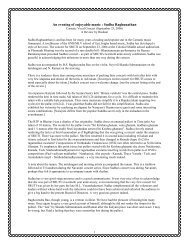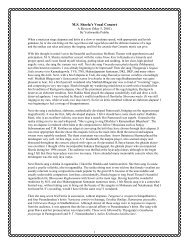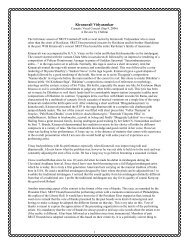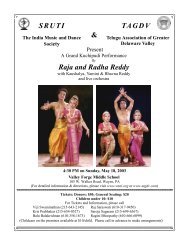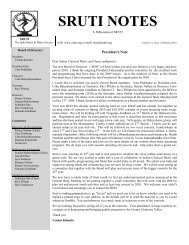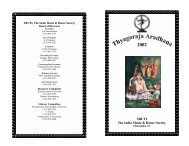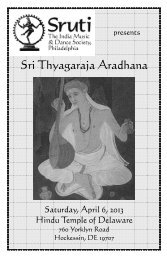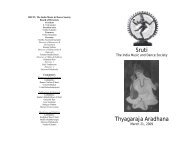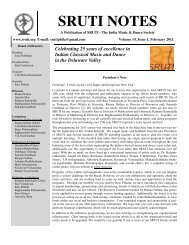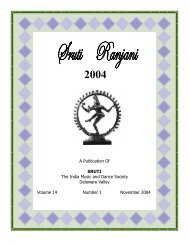PDF - SRUTI The India Music & Dance Society
PDF - SRUTI The India Music & Dance Society
PDF - SRUTI The India Music & Dance Society
You also want an ePaper? Increase the reach of your titles
YUMPU automatically turns print PDFs into web optimized ePapers that Google loves.
<strong>SRUTI</strong>, <strong>The</strong> <strong>India</strong> <strong>Music</strong> & <strong>Dance</strong> <strong>Society</strong>Board of DirectorsPresidentP. Narayanan610-526-0615Vice PresidentS. Rajagopal610-649-7623TreasurerC. Nataraj610-519-49942000Recording SecretarySivakumar Gopalnarayanan610-644-3659Corresponding SecretaryKishore Pochiraju609-520-0977Members at LargeRama Gundurao215-591-0380H. Ramakrishna610-240-0392Resource CommitteeRamana Kanumalla(Chairperson)610-277-8955Dinakar Subramanian610-630-1878Ravi Pattisam(610)837-1026Library CommitteeViji Swaminathan (Chairperson)215-643-2145Srinidhi Narayan610-989-3744Hema Ramamurthy215-295-1980Jeya Sankaran610-239-7894M.M. Subramaniam<strong>SRUTI</strong><strong>The</strong> <strong>India</strong> <strong>Music</strong> & <strong>Dance</strong> <strong>Society</strong>Philadelphia, PA
Saint Thyagaraja(1767-1847)<strong>The</strong> classical music of <strong>India</strong> has been an integral part of our spiritualheritage. A great many composers have contributed to the richtradition of Carnatic music which is essentially devotional. <strong>The</strong> sacredmemory of Sri Thyagaraja, the foremost of our saint composers, ishonored on the aradhana day by thousands of musicians offering tributeto the prolific composer.A great devotee of Lord Rama, Thyagaraja composed over 2000songs mostly in Telugu and some in Sanskrit. Simple, beautiful andsoul stirring, his style appeals to the layman and the scholar alike. Healso wrote two operas Prahalada Bhakthi Vijayam and Nowka Charitram.<strong>The</strong> Ghana Raga Pancharathna Kirtanas in the 5 ragas Nattai,Gaulai, Arabhi, Sri, and Varali, are considered to be the most scholarlycontribution of Thyagaraja to South <strong>India</strong>n <strong>Music</strong>. <strong>The</strong> composerseems to have condensed his musical genius, his matchless devotion toGod and the profound wisdom of the Vedanta teaching into these fiveimmortal kritis. Appropriately enough, the musical offering at thearadhana begins with the singing of the Pancharathna kritis in unison.[Some books on Thyagaraja: Spiritual Heritage Of Tyagaraja by V.Raghavan and C. Ramanujachari., Tyagaraja-Life and Lyrics by W.J.Jackson, Know your Thyagaraja by S.V.Krishnamurthy.]CONTENTSGhana Raga Pancharathna Kirthanas …….. 3Prabhakar ChitrapuThyagaraja Aradhana at Thiruvaiyaru …….. 9M.M. SubramaniamTwo Painting by Thyagaraja …….. 11Prabhakar ChitrapuAn Unforgettable Experience …….. 14Hema RamamurthyFine Arts – <strong>Music</strong> and <strong>Dance</strong> …….. 16Santosh Adipudi VardhanaMatch <strong>The</strong> Raga …….. 19Anjani ChitrapuThyagaraja Aradhana Word Search ……. 20Chetan RamamurthyCarnatic <strong>Music</strong> CrosswordSumanth Swaminathan .…… 21Nithyasree-Vocal (1996)Embar Kannan (V), Siva Kumar (M)Vani Satish-Vocal (1995)Satish (V), Mahesh Krishnamurthy (M)Sanjay Subramaniam-Vocal(1995)R.K. Sriramkumar (V), K. Arun Prakash (M)Sowmya-Vocal (1995)Narmada (V), Balaji (M)Bombay Jayashri-Vocal (1995)Vittal Ramamurthy (V), Palani Chakravarthy (M)Charumathi Ramachandran-Vocal (1994) M.S. Anantharaman (V),Skandaprasad (M)Sheela Ramaswamy-Vocal (1987)K.S. Mani (V), M.S. Venkatesh (M)Vijay Siva-Vocal (1993)Shriram Kumar (V), J. Vaidhyanathan (M)S.P. Ramh-Vocal (1994)Shashidhar (V), Satish Pathakota (M)25
<strong>SRUTI</strong> Concert TapesThis is a partial list of the more recent recorded concert tapes thatare available for distribution among the patrons of Sruti. To receiveany of these tapes and for a complete listing of tapes available, pleasecontact any member of the Library Committee or email your requestto viji_swaminathan@hotmail.com. Each concert is on 2 cassettesunless specified otherwise within parentheses. Prices for Srutimembers are: $10 for a two-cassette set and $15 for a three-cassetteset. Non-members should add $2 to the cost of each set. Please add$2.00 per set for shipping & handling.V=Violin,M=Mridangam,G=GhatamMysore Nagaraj and Manjunath -Violin (1999) ThiruvarurBhaktavatsalam (M)Neyveli Santhanagopalan-Vocal (1999)Delhi Sundararajan (V), SrimushnamRajarao (M)N. Ramani-Flute (1998)Srikant Venkataraman (V) Srimushnam Rajarao (M).Kadri Gopalanath-Saxophone (1997) Kanyakumari (V), GuruvayurDurai (M)T.N. Krishnan &Viji Krishnan Natarajan -Violin (1997)B. Harikumar (M), Vaikkom R. Gopalakrishnan (G)Balaji Shankar - vocal (1997)Ganesh Prasad (V), Poongulam Subramaniam (M)O.S. Thyagarajan-Vocal (1997) (3)Srikanth Venkataraman (V), Srimushnam Raja Rao (M)Shashank-Flute (1996)Gopinath (V), Satish Kumar (M), Tripunithira Radhakrishnan (G)Jayanthi & Padmavathi-Veena (1996)M.S. Sheela-Vocal (1996) (3)Nalina Mohan (V), Anoor Ananthakrishna Sharma (M), SukanyaRamgopal (G)GHANA RÀGAPANCHARATHNA KIRTANASPrabhakar Chitrapu[ <strong>The</strong> alphabets of Telugu and Sanskrit contain letters that do nothave a counterpart in the Roman alphabet. Thus I have used thefollowing scheme to denote the extra letters in Telugu. 1) s as in sura,2) s´ as in s´iva, 3) n as in nara, 4) ñ as in Gañapati, 5) r as in rama,6) r´ as in r´ushi, 7) l as in kalyani, 8) l´ as in varaal´i, 9) t as in nàta,10) th as in Thyàgaràja. Furthermore, it is important to clearlydistinguish long and short vowels. I have consistently used an accentabove the letter to indicate long sounds. Finally, in Telugu,elementary words are often combined to form composite words,through a process called "Sandhi". During this process, atransformation occurs at the junction of the two words, sometimesmaking it difficult to understand or even pronounce the longcomposite words. In such cases, I have separated the words by a plus(+) sign. For example, gaganaadhipa is written as gagana+adhipa.Acknowledgement: <strong>The</strong> author would like to acknowledge the consultationhelp given by Sri D. Raghavachary (the elder of the‘Hyderabad Brothers’) in translating these compositions.]1. Nàta Ràga - Àdi ThàlaJagada+ananda-kàraka Jaya Jànaki Pràna-nàyaka1. Gagana+adhipa Satkulaja Ràja RàjeswaraSugunàkara Sura-sèvya Bhavya-dàyaka Sada Sakala2. Amara-thàraka Nichaya-kumuda-hitha Pari-pùrna+anaghaSura Sura-bhùja Dadhi-payòdhi-vàsa HaranaSundara-thara Vadana Sudhà-maya Vachò-brunda GòvindaSànanda Màvara+ajaràpta Subhakara+anèka3. Nigama Nìraja+amruta Poshaka+animisha-vairiVàrida Samìrana Khaga-thuranga Satkavi Hrudàlaya AganithaVànara+adhipa Nathàmghri Yuga4. Indra-nìla-mani Sannibhàpa-ghana Chandra Sùryanayana+apramèyaVàgìndra Janaka Sakalèsa Subhra Nàgèndra-241
sayana Samana-vairi Sannuta5. Pàda Vijitha Mauni-sàpa Sava Paripàla Vara-mantra GrahanaLòla Parama Sàntha-chittha Janakaja+adhipa Saròja-bhavaVarada+akhila6. Srushti-sthityanta-kàraka Amita-kàmita Phalada Asamàna GàthraSachìpathi Suthàbdhi Sudhàkara Kusuma Vimàna SurasàripuKaràbjaSolutions for Match the Raga on page 19:1 -d, 2 -g , 3 -e, 4 -i, 5 -m, 6 -a, 7 -s, 8 -o, 9 -f, 10 –r, 11 -c,12 –b, 13 -j, 14 –p, 15 –q, 16 –t, 17 –k, 18 -l , 19 -h , 20 –n.Solution for Carnatic <strong>Music</strong> Crossword on page 20:7. Làlitacharana Avaguna Suragana Mada-harana Sanàtanà-janutha8. Om-kàra Panjara-kìra Purahara Saròjabhava Kèsava+adi RùpaVàsava-ripu Janakànthaka Kalà-dharàpta GhrunàkaraSaranàgatha Janapàlana Sumanò-ramana Nirvikàra Nigama-sàrathara9. Kara-dhrutha Sarajàla+asura Mada+apaharanà VanìsuraSuràvana Kavìna Bilaja Mauni Kruta-charitra Sannuta SriThyàgaràja Sannutha10. Puràna-purusha Nruvara+athmaja+asritha Para+adhìnaKhara-viràdha-ràvana Viràvana Anagha Paràsara ManòharaAvikruta Thyàgaràja SannuthaJagadanandakaraka...An admiration of God and his infinite manifestations.'O source of cosmic rejoice, Janaki's beloved, we cheer your victory!'Noble son of the solar race, Lord of the emperors,You are like the single moon among deathless stars,You nourish with the nectar of the lotus of the VedaYou are the Lord of Ahalya--your foot dispelled the rishi's curse,You are the Cause of creation, preservation and annihilationYou are the moon ascending from the sea of good peoples' minds,Siva, Brahma, Vishnu incarnate, you are the destroyer of demons--Khara, Viradha and Ravana,O Man of many qualities, consort of Lakshmi, Lion to the elephant ofsin, adored by Tyagaraja and others, Bliss giver to the worlds, wecheer your victory'.223
2. Gowla Ràga - Àdi ThàlaDudukù-gala Nannè Dora-koduku Bròchurà Enthò1. Kadu Durvishaya-krushtudai Gadiya Gadiyaku Nindàru2. Sri Vanitha Hruthkumudabja Avàng-mànasa Gòchara3. Sakala Bhùthamula-yandu Nìvai-yundagà Madi-lèka-bòyina4. Chiruta-pràyamula-nàdè Bhajanàmruta Rasavihìna Kutarkudaina5. Paradhanamula-koraku Norula Madi-karaga-balki KadupunimpaThirigi-natti6. Thana-madini Bhuvini Saukhyapu Jìvanamè Yanuchu SadàDinamulu Gadipè7. Thèliyani Nata-vita-kshudrulu Vanitalu SvavasamautaKupadisinchi Santasilli Swara-layambu Lerungakanu SilàthmulaiSubhakthulaku Samànamanu8. Dhrushtiki Sàrambagu Lalanà Sadanàrbhaka SènàmithaDhanàdulanu, Dèvàdi-Dèva Nera Nammithi-gàkanu, Nì Padàbja-Bhajanambu Marachina9. Chakkani Mukha Kamalambunu Sadà Nà Madilò SmaranaLèkanè Durmadandha Janula Kòri Pari-thàpamulachè DagiliNogili Durvishaya Duràsalanu Ròyalèka Sathathama ParàdhinaiChapalachitthudanaina10. Mànavathanu Durlabha-manuchu Nenchi Paramànanda- mondalèka;Mada Matsara Kàma Lòbha Mòhulaku Dàsudai MòsabòthiGàka; Modati-kulajudaguchu Bhuvini Sudrula Panulu SalpuchuNuntini Gàka; Naràdhamulanu Ròya Rasa VihìnamayinanuSàdhimpa Thàrumàru11. Sathulaku Konnallasthikai Suthulaku Konnàllu DhanathathulakaiThirigithinayyà Thyàgaràjàptha Ituvanti223
Duduku...<strong>The</strong> composer is introspective, repents about his shortcomings andappeals to Rama to be his kind savior.“Which Lord, but you, will save a blundered soul like me?”“I have been entrapped by evil thoughts and deeds;I have been blind to your omnipresence;I have, from my very early childhood, indulged in vain arguments andnever enjoyed the essence of bhajan in your praise;I have resorted to flattery and swindled other’s wealth;I have wasted life seeking mundane pleasures and trivial comforts;I knew neither swara nor laya and pretended to be your loyal devotee;I succumbed to worldly ways and bad company, and ignored yourworship.Who, but you, will save me?”3. Àrabhi Ràga - Àdi ThàlaSàdhinchanè O Manasà1. Bòdhinchina Sanmàrga-Vachanamula Bònku-chèsi Thàpattinattu2. Samayàniki Thagu Màtalàdenè3. Dèvaki Vasudèvula Nèginchinatu4. Rangèsudu Sadgangà Janakudu Sangìtha Sampradàyakudu5. Gòpì-Manòradha Mosanga-lèkanè Gèliyu Chèsè-vàdu6. Vanithala Sadà Sokka Jèyuchunu Mrokka Chèsè Paramàtmudadhiyu-gàkaYasòdha Thanayundanchu MudhambunanuMuddhu-betta Navvuchundu HariClues for crossword on page 20.(Solution on page 23)Across3. ——— Tala (8 beats)7. She wrote Thiruppavai.8. Cycle of tala9. Nandanar Charithram is his greatest gift to music.10. Shyama Sastri perfected this to its present form.11. Raga used for initial lessons in Carnatic music.12. Creator of the musical form Kriti.14. A Navagraha Kriti is in praise of this planet20. His Navarathna Malai has kritis representing 9 kinds of Bhakthi.21. She came back to life when Rama’s feet touched her.22. Variation of a melodic line of a composition.23. <strong>The</strong> origin of <strong>India</strong>n music can be traced back to this.Down1. <strong>Music</strong> exercises based on the basic talas.2. Sadashiva Brahmendra composed Manasa Sancharare in thisraga.3. Usually precedes a kriti in a concert.4. Composer of Krishna Nee Begane Baaro5. Composer/film sonwriter/actor6. Author of Krishnaleela Tarangini.13. He specialized in group kritis.15. 17th century composer of Telugu padams.16. Masterpiece of Jayadeva17. An auspicious raga for mangalam.18. <strong>The</strong> Kriti form was perfected by him.19. <strong>The</strong> Ishta Devatha of Swathi Thirunal.21. ——— mata, laya pitha7. Parama Bhaktha Vatsaludu Suguna Pàràvàrundu ÀjanmamanghudìKali Bàdhala Thìrchu Vàdanuchunè-hrudayambujamunaJùchuchundaga8. Harè Ràmachandra Raghukulèsa Mrudubhàsha SèshasayanaParanàrì Sòdharà Javiràja Thuranga Ràjaràja Vinutha421
Carnatic <strong>Music</strong> CrosswordSumanth SwaminathanNiràmayàpaghana Sarasìruha Dhalàksha Yanuchu VèdukonnanuThà Bròvakanu9. Sri Venkatèsa Suprakàsa Sarvònnatha Sajjanamànasa NikèthanaKankàmbaradhara Lasanmakuta Kundala Viràjitha Harè!Yanuchu Nè Pogadagà Thyàgaràja-gèyudu MànavèndrudainaRàmachandrudu10. Samayàniki Thagu Màtalàdene; Sadhbhakthula Nadatha LitlanenèAmarikagà Nà; Pùja-konenè Alugavaddhanenè; VimukhulathòJèrabòku-manenè; Vetha Galgina Thàlukommanenè;Damasamàdi Sukhadàyakudagu Sri Thyàgaràjanuthudu ChenthaRàkanèSummarySadhinchene...<strong>The</strong> composer reminds himself of subtle and mysterious ways of theGod and reiterates it by referring to several episodes involving Ramaand Krishna.Clues on next page“Sri Rama was tenacious in getting His way even if it meant breakinghis own words of wisdom.”“He spoke with tact to suit the occasion;I am not alone in this.”“He was mischievous to his own parents Devaki and Vasudeva;Teased the gopis without satisfyng their desires;Smiled at Yashoda mysteriously when she expressed her maternalaffection;Although He is a great savior of bhaktas, he never answered myprayers to free me from the misery of the world;He appreciated my prayers and worship, but evaded me;He asked me not to be annoyed or disappointedHe advised me not to join bad company and be persistent”[Sumanth is a High School Junior and learnsvocal and saxophone music.]205
4. Varàli Ràga - Àdi ThàlaKana Kana Ruchirà Kanakavasana Ninnu1. Dina Dinamunu Manasuna Chanavuna Ninnu2. Pàlugàru Mòmuna Sri Yapàra Mahima Danaru Ninnu3. Kala Kala-manu Mukha-kala Galigina SìthaKulukuchu Ora-kannulachè Ninnu4. Bàlàrkàbhasu Chèla Manimaya Màlàlamkrutha KamdharaSarasijàksha Varaka Pòla Suruchira Kiritadhara SathathambuManasàraga5. Sàpathnìmàthayow Suruchichè-karna Sùlamaina-màta VìnulaChuirukkana Thàlaka Sri Harini Dhyànimchi Sukhimpaga-lèdaYatu6. Mrugamadalalàma Subhanitala Varajatàyu MòkshaphaladaPavanamànasutudu Nìdhu Mahima Delpa Sìta <strong>The</strong>lisi ValachiSokkalèdharìthi Ninnu7. Sukhàspada Vimukhambudhara Pavana VidèhamànasaVihàràptha Surabhùja Mànitha Gunàmka Chidànanda KhagaThuranga Dhrutaradhànga Parama Dayàkara KarunàrasaVarunàlaya Bhayàpahàrà Sri Raghupathè8. Kàminchi Prèmamìra Karamula Nìdu PàdakamalamulaBattukonuvàdu Sàkshi Ràmanàma Rasikudu Kailàsa SadhanuduSàkshi Mariyu Nàrada Paràsara Suka Saunaka Purandara NagajàDharaja Mukhyulu Sàkshigàda Sundarèsa Sukha KalàmbudhiVàsàsrithulakè9. Sathathamu Prèma Pùrithudagu Thyàgaràja nuta mukhajithaKumudahitha Varada NinnuSummaryKanakana...A description of Sri Rama’s glory, dignity and divine grace.“Its a recurring joy to ‘see’ you, Sri Rama, clad in golden wraps, withgems and jewels glittering brightly around your neck.6only to understand a higher power, but also to understand a more humanone. And so, whether for reaching towards heaven, or for creatingunity on Earth, our fine arts such as music and dance, throughtheir portrayal of the Hindu religion and <strong>India</strong>n culture(s), have beenand continue to be a true example of the power of the human spirit.[ Santosh is a freshman at Upenn. This essay on <strong>Music</strong>, <strong>Dance</strong> andHindu Religion was the prize-winning entry in a competition organizedby the Council of Hindu Temples of North America.]Match the RagaAnjani ChitrapuGrowing up in a South <strong>India</strong>n household in this country, we hearour parents/friends sing or play a number of Carnatic music songs. Ihave put together a quiz listing of some of the popular songs that Ihave heard. Try to match them against the correct raga. (I havelooked up my dad's books to identify the ragas). Enjoy!(Solution on page 23)A. Songs B. Raga1. Ma mava raghu rama a. Kesari2. Kala harana melara b. Hindolam3. Swaminatha pari palaya c. Jayantasri4. Entha nerchina d. Saranga5. Kamakshi e. Nattai6. Nannu kanna talli f. Vagadeeshwari7. Shakti saahitha Ganapathim g. Suddha Saveri8. Endro mahanu bhavalu h. Jagan Mohini9. Paramathmudu i. Shuddha Dhanyasi10. Pranamamyaham j. DevaGandhari11. Marugelara k. Madhyamavati12. Samaja vara gamana l. Saramati13. Kshira saagara m. Bhairavi14. Manasa yetu lo n. Mohana15. Vedalenu ko dandapani o. Sri16. Vatapi Ganapathim p. Malayamarutham17. Bhagyada Lakshmi q. Todi18. Mokshmamu galada r. Gowla19. Shobillu s. Shankarabharanam20. Rama ninnu nammina t. Hamsadhwani[Anjani is a fifth grader at the BlueBell Elementary School.]19
general and Hindus in particular? Well, if so, then our music anddance provide the unique bridge that connects our religion with ourculture or perhaps more aptly our cultures. For, <strong>India</strong> represents notone but a rich blend of varied cultures, some linguistic, some geographic,but all with the underlying common set of values that are anintegral part of our religion. Our music and dance exemplify the cultureof the time and place of their origin; the Kuchipudi dance style isan example of the culture in the Krishnadevaraya dynasty; Bharathanatyamportrays the culture in the Chola dynasty and Mohiniyattamis a unique example of the Kerala culture. Religion is the commonthread that runs through all of them, be it the splendour of“Srinivasa Kalyanam”, the triumph of love and devotion over wealthin “Sri Krishna thulabhaaram” or the extinction of evil in“Narakaasura Samhaaram”.<strong>India</strong>n music and dance are unique in allowing the artists thefreedom to interpret and project their values. Take music, for example.Almost all other forms of music use harmony as their platform.However, in <strong>India</strong>n music harmony takes a back seat; melody completelydominates. Additionally, whereas most European and Westernmusic is based on an extremely rigid platform, <strong>India</strong>n music gives theperformer the ability to interject his/her own style and his/her owninterpretation of the song/composition by using variations of thenotes. <strong>The</strong>se are known as "sangatis". <strong>India</strong>n dance contains a similarpotential for individuality. One of the fundamental concepts ofboth <strong>India</strong>n religion and culture is the concept of "manodharma",which states that each person has the unique ability to interpret religionand culture as he/she sees fit. This concept is extremely strong inboth <strong>India</strong>n music and dance – that’s why the kriti, “Upacharamu”composed by Thyagaraja in raga Bhairavi sung by M.S. Subbulakshmisounds different but equally enjoyable when compared to a renderingof the same piece by the late Maharajapuram Santhanam; orthe Bhajan Isathana dhan ke by Kabir Das when presented by differentsingers; so is a portrayal of “Ardhanaareeswaram” or “Sri Krishnathulaabhaaram” or “Srinivasa Kalyanam” by different dancers – eachartist’s presentation with a unique personal stamp and style. <strong>The</strong> centraltheme of our religion – that all religious practices are but differentpathways leading to the final goal of Moksha or Salvation – finds expressionin this freedom that our artists enjoy and respect. Unityamidst diversity and freedom to explore and experiment are practicesand not just slogans in our culture and religion and our fine artsuniquely illustrate this commitment.From selfless worship to dancing deities, from raga tomanodharma, music and dance have been the tools for society not18Didn’t Dhruva find solace in your dhyana when Surichi, his stepmother,tortured him with harsh words?Didn’t Jatayu attain moksha by your presence alone?Wasn’t Sita ecstatic when Hanuman narrated your glory?Anjaneya, Lord Shiva, Indra, sage Narada and others attest to yourcharm and magnificent beauty.5. Sri Ràga - Àdi ThàlaEndarò Mahànubhàvulu+Andariki Vandanamul+endarò1. Chanduru Varnuni Anda-chandamunu Hrudaya+ aravindamunuJùchi Brahma+ananda+manubhavinchu Vàr+endarò2. Sàma-gàna-lòla Manasija-làvanya Dhanya-mùrdhanyul+ endarò3. Mànasa Vana-chara Vara Sanchàramu Nilipi Mùrthi BàgugaPodaganè Vàr+endarò4. Saraguna Pàdamulaku Svàntamanu Saròjamunu SamarpanamuSèyuvàr+endarò5. Pathitha Pàvanudanè Paràthparuni Gurinchi ParamàrdhamaguNija-màrgamuthonu Pàduchunu Sallàpamuthò Swara-laya+adiRàgamula Teliyu Vàr+endarò6. Hari-guna Manulagu Saramulu Galamuna Sòbhillu Bhakthakotul+ilalò<strong>The</strong>livito Chelimitò Karuna+kalgi JagamellanuSudhà-drushtichè Bròchu Vàr+endarò7. Hoyalu-mìra Nadalu+kalgu Sarasuni Sadà Kanula JùchuchunuPulaka-sarìrulai Ananda Payòdhi Nimagnulai MudambunanuYasamu Gala Vàr+endarò8. Parama Bhàgavatha Mauni-vara Sasivibhakara SanakasanandanaDigìsa Sura Kimpurusha Kanakasipu-suta NàradaThumburu Pavana-sùnu Bàlachandra-dhara Suka-saròja-bhavaBhù-sura-varulu Parama-pàvanulu Ghanulu Sàsvathulu Kamalabhava-sukhamuSada+anubhavulu Gàka Endarò9. Nì Mènu Nàma Vaibhavammulanu Nì Paràkrama DhairyamulaSàntha Mànasamu Nìvulanu Vachana Satyamunu Raghuvara! Nì7
Yeda Sadbhakthiyu Janinchakanu Durmathamulanu KallaChèsinatti Nì Madi Neringi Samthathambunanu Gunabhajana+anandaKìrtanamu Sèyu Vàr+endarò10. Bhàgavatha Ràmàyana Gìta+adi Sruthi Sàsthra PurànapuMarmamulan Siva+adi Shan-mathamula Gùdhamula MuppadiMukkòti Sura+antharangamula Bhàvamula Neringi Bhàva-ràgaLaya+adi Saukhyamulache Chira+ayuvul+kaligi NirapadhiSukha+atmulai Thyàgaràja+aptulaina Vàr+endarò11. Prema Muppiri-gonu-vèla Nàmamunu Dalachè-vàru RàmabhakthudainaThyàgaràja-nuthuniki Nija-dàsul+endaròSummaryEndaro...An appreciation of great human beings and their virtues.“Many are the enlightened minds and I salute them all”“Many are those who realize God in their hearts and experience theultimate joy;Many are those who delight themselves in the chants of sama vedaand ‘see’ the Lord’s glory;Many are those who offer themselves as flowers to the Lord;Many enlightened are those who pursue the truth, know swara, layaand raga, and praise the Lord;Many are the bhaktas who enrich the world with their wisdom, loveand compassion;Many are those who are enthralled by your majesty;Many are the great sages and ardent devotees who ‘experience’ theGod;Many are those dear to Thyagaraja who understand the scriptures,religion and rejoice bhava, raga, laya and other elements of music;Many ardent devotees of Sri Rama, I salute them all.”[ <strong>The</strong> summaries were compiled by Drs. Vasant Kumar and UmaPrabhakar, using the following sources: 'Spiritual Heritage Of Tyagaraja'by V. Raghavan and C. Ramanujachari., 'Tyagaraja Keertanaalu'by V. Veerabhadra Sastry and 'Tyagaraja-Life and Lyrics' by W.J.Jackson.]8as devotional as the hymns we hear in a local temple. If we listen tothe lyrics of the very popular Nannu Vidachi (Raga Reethi Gowla):Baaguga Nannelu Kovara?Thyagaraja Nutha Eethanuvu NeederaNannu Vidachi KadalakuraaAnd we hear Thyagaraja mourning, "I cannot bear being out of yourpresence even for a moment, Lord, adored by Thyagaraja. DearRama, do not leave me, do not go, I am all yours", how can we reallyseparate music from religion? Or the message conveyed through theabhinayam of Dasaavatara or Daksha Yagna? Or the outpouring ofdevotion and love for Krishna in Meera Bhajans, as in Hari... thumharo? Truly music and dance display the most basic form of expressingone's religion: through worship.Another expression of this close knit integration betweenmusic and dance on one hand and Hinduism on the other can be foundin the themes and stories depicted by some of the best known dancepresentations. <strong>The</strong> stories of angels, demons, and gods that we readof in scriptures are but the means by which to understand the moraland spiritual values of our religion. However, oftentimes the religiousanecdotes that we read in the Vedas or other religious scriptures seemabstract and unreal without a visual frame of reference. <strong>Dance</strong>, particularly,gives us that visual image, helps us make the connection,and understand the meaning and message behind the actions portrayed.And with understanding comes appreciation of the valuesexemplified by the artist’s presentation. If we look, for example, atthe dance performance Jaya Jaya Devi, composed by the very famousLalgudi Jayaraman, we learn the story of the different moods andphysical manifestations of Goddess Parvati. More importantly, however,by watching this performance, we learn of the ongoing strugglebetween good and evil as well as the values that characterize bothgood and evil. And this value system we learn is fundamental to ourunderstanding of Hinduism, which teaches us to emulate many of thecharacter traits shown by Parvati: of strength, compassion, and goodwill.<strong>Dance</strong>, thus adds the visual dimension to enhance our understandingof our religion and culture. So by allowing us to visualizevarious aspects of our religion, music and dance enhance our understandingof the moral, ethical, social and spiritual values that Hinduismis imbibed with.Both <strong>India</strong>n music and dance are then pathways to a betterunderstanding of our religion. But what about ourselves? Our culture?Isn't culture a measure of everything that unifies us as <strong>India</strong>ns in17
<strong>The</strong> podium and the pandal built for the Aradhana were sightsby themselves. With the thousands of people gathered together to payrespects and homage to the great saint & composer and one of theTrimurthys of Carnatic music, there was a sense of reverence andhumility in the air. <strong>The</strong> famous and well-known artists and evensome of the unapproachable ones were present[Hema Ramamurthy is a life member of Sruti and a member of theLibrary Committee.]Fine Arts ~ <strong>Music</strong> & <strong>Dance</strong>Santosh Adipudi VardhanaWhat do we have within us that is good enough to give to thegods? Or to each other, for that matter? Born mortal and doomed toan inescapable lifetime of fallibility, the men and women of societydecided to give those higher controlling powers, the gods, the greatestgift they could ever give, the manifestation of the human spirit. Todaywe call it art. In some countries this means poetry; in others,something else. But for us <strong>India</strong>ns, art brings to mind two things:music and dance. But this <strong>India</strong>n art is not merely a manifestation ofhuman spirit; it is a manifestation of the uniquely <strong>India</strong>n spirit. Andso the vehicles by which we become closer to God become the vehiclesby which we become closer to one another as well. And thosevehicles are <strong>India</strong>n music and dance and they are part and parcel ofour Hindu Religion and Culture. As is the case in several Easterncultures, the classical side of our music and dance have religion andworship as their primary themes while culture finds an expression inthe popular or folk music and dance art forms.Perhaps the most apparent evidence of this strong relationship(between our music and dance and our Hindu religion) is the verymessage that these art forms convey. Many forms of classical music,for example, are direct forms of worship. Many of the greatest devoteesin <strong>India</strong>'s history are composers whose compositions are a resultof their utter devotion to God. Who better to use as an example thanthe great Thyagaraja? Thyagaraja is regarded by many as perhaps thegreatest confluence of music and devotion or Bhakti - a man who recitedLord Rama's name 960 million times in order to become onewith God. Many of Thyagaraja's compositions that we sing today areThyagaraja Aradhana at ThiruvaiyaruM.M. SubramaniamThiruvaiyaru. A small town in idyllic Tanjavur district, TamilNadu, <strong>India</strong>. A place where a few hundred years ago, a man walkedon its streets, “begging” for his daily food and in doing so attracted alarge following. A man who revolutionized South <strong>India</strong>n classicalmusic structure as no one else before him or after. One of the greatestcomposers of classical music in any genre, he lived a long life, composingand passing on his marvelous outpourings to a legion of discipleswho spread it all over South <strong>India</strong>.His name was Thyagaraja, named after the presiding deity ofThiruvarur temple where he was born. A name revered whereverCarnatic music is performed.A few years after his death in 1847, a group of his disciplesgathered, annually on his death anniversary, at the place of hissamadhi on the banks of river Kaveri to perform an aradhana. Thistradition has become THE ARADHANA that many Carnatic musiclovers wish to attend at least once in their lifetime.I was able to fulfill this year my long held wish to attend thearadhana. It took place this year on 25 January. <strong>The</strong> village whereThyagaraja grew up has grown to be a small overcrowded town. Onthe aradhana day, one could see many musicians walking, some ofthem bare feet, from Thirumanjanam Street, where the composer livedand the samadhi on the banks of Kaveri.<strong>The</strong> aradhana was conducted in a large pandal, which could haveaccommodated about 1500 persons. Every one, rich or poor, VIP orcommoner, famous or not had to sit on the sands of the riverbed.Many of the devotees had arrived the previous night itself, slept in thepandal and after an early bath in the river, took vantage positions inthe front. <strong>The</strong> aradhana was scheduled at 10:15 a.m. I arrived withmy brother-in-law and his wife at about 7:30 and could only get seatsabout 15th row from the place where the main musicians sat. And wehad VIP tickets!<strong>The</strong> aradhana was organized with meticulous care. <strong>The</strong> fact thatit was televised live nationally may have had a bearing on the punctuality.On the morning of the aradhana, some of the musicians donnedperiod clothes and simulating the uncha virutti tradition that Thyagarajaused, walked from Thirumanjanam Street to the samadhi. All the169
while nadaswaram music was played by leading nadaswara vidwansin the pandal. After the uncha virutti musicians arrived in the pandaland sat down and before the singing of the Pancharatna kritis, flutistsled by veteran N. Ramani played the Bhairavi kriti “Chetulara”.<strong>The</strong> rendering of the Pancharatna kritis was, of course, the highpoint of the Aradhana. <strong>The</strong>re certainly was an aura of spirituality asthe musicians performed facing the statue of the composer at thesamadhi. Some of the leading daily papers had included the completepancharatna kritis with swarams and sahityams. <strong>The</strong>y were distributedfree to the audience to help them follow the main musicians.It was quite a thrilling experience, accentuated by the fact thatmany in the audience also participated. Almost right next to me anamateur mridanga vidwan was accompanying the music. And a fewrows to the front a couple of kanjira players were doing the same.Many others were singing along the kritis with varying degrees ofintensity.<strong>The</strong> aradhana celebrations in Thiruvaiyaru were conducted thisyear over a week. I understood that almost any musician who wantedto sing or play an instrument was allowed a chance. Each day’s programstarted at 10 a.m. and went on till almost midnight. Most seniormusicians usually performed during the evenings or nights. <strong>The</strong> juniorand other not well known musicians were given 10 minutes eachto perform while the better known and senior musicians were givenslots of 20 minutes.<strong>The</strong> musicians performed on one of two raised daises almostnext to each other. Even as one musician was about to finish, the musicianslated to perform next came on the other dais. <strong>The</strong> list containingwhich musician would perform on what day and when was printedand distributed. <strong>The</strong> whole arrangement seemed to go with clockworklike precision.<strong>The</strong>re was lot of activities going on outside the pandal also.Many vendors, especially of cassettes/CDs and music books pliedtheir trade. <strong>The</strong>re were food stalls, concession stands, etc. (<strong>The</strong> organizershad arranged for free lunch and dinner for every one attendingthe aradhana. This took place both at the aradhana site as well as atThirumanjanam Street house.) People gathered around trees andwherever some shade could be found to exchange information, mayberenew old friendships ... I chanced to meet a couple of friends fromNew Jersey![Dr. M.M. Subramaniam is a founder member of <strong>SRUTI</strong> and a pastpresident]10Though chairs were available, most people preferred to make themselvescomfortable-sitting on the floor, and bringing blankets to wardoff the cold. <strong>The</strong>re were a few snack bars outside that people frequentedto during the course of the night. <strong>The</strong>re were also many vendorsselling music tapes, CDs, and books.<strong>The</strong> stage was very well decorated, with a nice backdrop madeup of fresh flowers. It was very artistically done each day. On eitherside of the stage there were two huge TV screens on which the programwas projected allowing a clear view of the performers to theaudience. <strong>The</strong>re were also TV cameras and major audio companiesbusy with recordings.Getting to the Nehru stadium posed no problems. <strong>The</strong> autorickshawand taxi drivers were familiar with the festival and evenengaged in conversation about the artists who were going to be performingthat evening. However, Pune, being a large town with a diversepopulation, had quite a few people who were not involved oreven interested in music. I felt they lived a life quite untouched bythe magnanimity of the event that was taking place in their ownhometown.This was in striking contrast to what I saw in the small village ofThiruvaiyaru, on the banks of the river Kaveri, in the Tanjore District.A quaint village, a village that could easily be overlooked at othertimes, comes under limelight during the Thyagaraja Aradhana festival.It is a tradition that has continued ever since it was started bysome of Thyagaraja’s disciples in 1847 to pay respects to him. Wecould see the involvement of everyone in the community as soon aswe entered the village. With banners flying, houses decorated withfresh flowers, elaborate rangolis in the front yard, it felt like thewhole village was getting ready for a festival. In front of somethatched huts, we saw some spectacular rangolis, with different posesof Thyagaraja. We felt compelled to take photographs of some ofthem (with the owners’ permission of course). <strong>The</strong> Panchanadeeshwaratemple stands as an example of the huge temples of south <strong>India</strong>,with its enormous avarnams. <strong>The</strong> size of the temple stands out in mymemory. For a village as small as Thiruvaiyaru, the enormous templestood as a focal point, reflecting the important role the temple playedin people’s lives. <strong>The</strong> Panchanadeeshwara temple, I heard, gets itsname from the fact that the five rivers (the Kaveri and its tributaries)flow apart from each other in the short distance between Tanjore andThiruvaiyaru.15
An Unforgettable Experience…Hema RamamurthyLast year, I had the opportunity to attend two well-known musicevents in <strong>India</strong>. <strong>The</strong>y were the Sawai Gandharva Festival in Pune andthe Thyagaraja Aradhana at Thiruvaiyaru. I had heard of these eventsever since my childhood and hoped to attend them someday. I amglad I got a chance to take these trips.With the video tapings of these programs and the present daymass communication in place people get to view these programs inthe comfort of their living rooms. But I wanted to see and experiencesomething more: the experience of being there in person, feel the musicin the air, and be with thousands of people who gather from nearand far away places just for the love of music. I think one has to be inthese places to feel the energy and spirit floating in the atmosphere.<strong>The</strong> Sawai Gandharva festival I attended was conducted on Dec9 th , 10 th , and 11 th , of ’98. As is the custom, the programs were conductedduring the night. It’s an all night program, starting at 8:00pmand lasting until 6:00am the next day. Each artist was given a timeslot of 1½ to 2 hours. <strong>The</strong> program included Shenai, Sitar, and vocalperformances by some very well-known and some not-so-well-knownartists. <strong>The</strong> program concluded with the vocal performance by thefamous artist, Feroz Dastur of Kirana Gharana, which topped the festivaland brought it to a grand finale. (Pt. Bhimsen Joshi traditionallydid the honor, but because of his illness, he was unable to participate.)Ganapathi Bhatt from Karnataka captured the hearts of the audiencewith his music and was among those who made it worthwhile to beawake in the wee hours of the morning. <strong>The</strong> program ended on themorning of Dec 11 th , with a playing of a recording of Sawai Gandharva,and everyone remembering and paying homage to this greatgiant in the music field.<strong>The</strong> venue for the Sawai Gandharva festival had changed. Foryears, the festival was held outdoors. <strong>The</strong> previous year the festivalhad to be postponed due to severe rain. <strong>The</strong> festival in ’98 was heldindoors in the Nehru stadium, the capacity of which I think was about3000. (I’m not sure about the exact number) This, I heard, is a verysmall number compared to the 10000-15000 people that used togather for the previous festivals that took place outdoors. <strong>The</strong>re werepeople of all ages: young college students, older people and manyyoung couples (some with small children falling asleep on their laps).Two Paintings by ThyagarajaPrabhakar ChitrapuThyagaraja was also a painter. A painter of portraits, for example,like Rembrandt van Rijn. A painter of abstract ideas, for example,like Salvador Dali. Thyagaraja’s medium of painting was made up ofWords and <strong>Music</strong> and his driving forces were Rama Bhakti and <strong>Music</strong>alCreativity.<strong>The</strong> kriti, Nanu Palimpa, is an example of a portrait painting, inwhich Thyagaraja depicts the colors and hues of Sri Rama: glowingblue of the body, shining white of the pearl necklace, and golden lightof the bow.<strong>The</strong>re are two other kritis, which are more like paintings of abstractconcepts. One is (Pranava)-Nada-sudha-rasambu-ilanu-naraakriti-aye,in which Thyagaraja describes his concept of how the primordialsound, Pranava Nada, takes the concrete shape of Carnatic<strong>Music</strong>, by drawing an analogy to how the Universal God took thespecific human form in Rama. <strong>The</strong> other is Bantu-rithi-koluvuiyyavayya,in which Thyagaraja draws an analogy between the way inwhich a Rama-bhakta is protected by Rama-bhakti and the way inwhich a soldier is protected by his armor, shield and sword. I willexpand on these two kritis below.Pallavi:Nada-sudha-rasamibu+ilanu-nara+akriti-aayePranava-Nada-sudha-rasamibu+ilanu-nara+akriti-aayeAnupallavi:Veda+agama-sastra-purana+adulaku+aadharamainaNada-sudha-rasamibu+ilanu-nara+akriti-aayePranava Nada-sudha-rasamibu+ilanu-nara+akriti-aayeCharanam:Swaramulu-aaru+oka-Gantalu,Vara-raagamu-Kodandamu,Dura-naya-desyamu Tri-gunamu,Niratha-gathi-Saramu-raa!Sarasa-sangathulu sandarbhamu-gala giramulu-raa !Dhara-bhajana-bhaagyamu-raa!Thyagaraju-sevinchu-Nada-sudha-rasamibu+ilanu-nara+akriti-aayePranava Nada-sudha-rasamibu+ilanu-nara+akriti-aaye1411
In the Pallavi, Thyagaraja says the Nada-sudha-rasamu (thesweet juice of Nadam) took the form of human (nara+akriti-aaye) onearth (ilanu). In fact, it is the Pranava-Nadam, the primordial soundOm, which took the human shape. Although Thyagaraja says ‘human’form in general here, he is referring to Rama’s human-form, as it willbe clear in the charanam.In the Anupallavi, Thyagaraja goes on to claim that it is verilythat Nadam and Pranava Nadam, which is the source and support(aadharamaina) of Vedas, Aagamas, Sastras, Puranas and all the rest(veda-aagama-sastra-purana-aadulaku) !In the final part of the kriti, Thyagaraja lets his imagination freeand paints a beautiful picture of the Rama’s human-form that thePranava-Nadam has taken. <strong>The</strong> analogy is between the Rama and the(Carnatic) <strong>Music</strong>, and Rama’s ornamentations and various aspects of(Carnatic) <strong>Music</strong>.Firstly, the seven (aaru+oka=6+1) notes (swaramulu) of(Carnatic) <strong>Music</strong> have become the tinkling little bells (gantalu) of(presumably) Rama’s crown. <strong>The</strong> beautiful (vara) raagam has becomeRama’s bow, the Kodandam. <strong>The</strong> three aspects of rendering(Carnatic) <strong>Music</strong>, Dura (speed)-Naya (grace & beauty)-Desyam(colloquialism), are the three human Gunas (Satva, Rajas, Tamo). <strong>The</strong>progressive tempo (niratha-gati) has become the arrow (saramu). <strong>The</strong>lilting sangathis are indeed the appropriately-spoken speech(sandarbhamu-gala giramulu).I find these comparisons fascinating: for example, the sevennotes, as in kalpita swaras at the end of a kriti, produce sounds asshort and varied as the sounds of small tinkling bells. Similarly, expositionof a Raga is extensive and long, so that the comparison to along bow seems fitting. <strong>The</strong> comparison between quick and directedprogression of a kriti and an arrow is fitting as is the comparison betweensangathis and well spoken words!Now Thyagaraja wraps up the charanam, by saying that in this world(dhara), being able to perform Rama Bhajana is a good fortune(bhagyam). <strong>The</strong> Nada-sudha-rasam, worshipped by (sevinchu) Thyagaraja,has indeed taken human form.Pallavi:Bantu-rithi koluvu+iyyavayya Rama !Anupallavi:Thunta-vinti-vaani modalaina mada+aadula nela-kuula-jeyuNija-bantu-rithi koluvu+iyyavayya Rama !Charanam:Roma+aanchamane ghana-kanchukamuRama-bhakthudane mudra-billayuRama-namamane vara-khadgamu+idiRaajillunayyaThyagarajuniki Bantu-rithi koluvu+iyyavayya Rama !Thyagaraja starts the kriti by asking Rama to keep him near(koluvu+iyyavayya), as He would a soldier/servant (bantu).Keep me, says Thyagaraja, as you would a true servant (nijabantu-rithi),who would bring down (nela-kula-cheyu) arrogant(mada) ones, such as Manmatha, who carries a flower bow (thuntavinti-vaani= Manmatha) etc (aadula).Once again, here in the charanam, Thyagaraja produces the mostbeautiful (hyperbole!) analogy between the soldier’s attributes andthose of a Rama-bhakta. Roma-aanchanamu is the raising of bodyhair, which can happen during spells of devotional rapture. This verypersonal experience of Thyagaraja is compared to the majestic armor(ghana kanchukamu) of a soldier ! <strong>The</strong> idea is that the risen-hair coversthe bhakta’s body and protects him as the armor covers a soldier’schest and protects him ! I find this comparison really fascinating.Thyagaraja goes on to complete the analogy, by saying that thedesignation as a Rama-bhaktha is like an in-signia-bearing shield(mudra-billa) of a soldier. And, Rama nama shines (raajillunu) as thegreat sword (vara khadgamu) of the soldier. Please keep this Thyagarajanear you as you would a trusted servant.Note: Translation of several words, such as Dura, Naya, Desyamu,Nirathagati, Giramu, posed a challenge for me. I am not surethat I translated them accurately. I would appreciate very much if youcould share your thoughts/corrections.[Dr. Prabhakar Chitrapu, a life member of Sruti, has served onSruti’s board as a vice-president and is a frequent contributor toSruti’s publications.]1213



